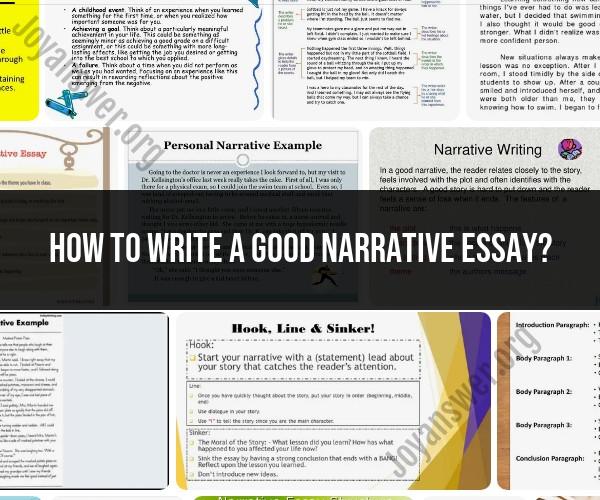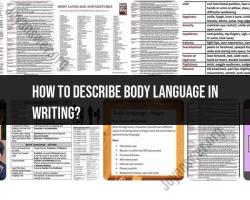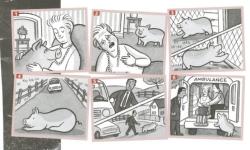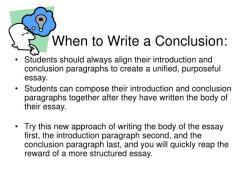How to write a good narrative essay?
Writing a good narrative essay involves telling a compelling story in a way that engages your readers and conveys a clear message or theme. Here's a step-by-step guide to help you write a successful narrative essay:
Choose a Topic:
- Select a topic that you can relate to and that has personal significance to you. It could be an event, a memorable experience, or a moment that had a profound impact on your life.
Plan Your Story:
- Determine the purpose of your narrative. Are you aiming to entertain, inform, persuade, or reflect? Understanding your goal will help shape your story.
- Create an outline that includes the key elements of your narrative: the introduction, the main events or experiences, and the conclusion. Consider how you'll start and end your essay to capture your readers' attention and leave a lasting impression.
Craft a Compelling Introduction:
- Begin with a hook: Start your narrative with an attention-grabbing sentence or anecdote that draws readers in. This could be a quote, a question, or a vivid description.
- Provide necessary context: Briefly introduce the setting, time, and place of your story to help readers understand the background.
- Present the thesis statement: State the central theme or message you want to convey through your narrative. This will serve as your essay's focus.
Develop the Body of Your Essay:
- Organize your story chronologically: Describe the events in a logical sequence, so readers can follow your narrative easily.
- Show, don't tell: Use descriptive language, sensory details, and dialogue to make your story come alive. Engage the readers' senses and emotions.
- Include conflict and resolution: A good narrative often involves some form of conflict or challenge that the protagonist must overcome. Highlight the obstacles and how they were resolved or dealt with.
- Use transitions: Use transition words and phrases to guide readers through the story and maintain coherence.
Create a Memorable Conclusion:
- Summarize the main points: Remind readers of the central message or theme of your narrative.
- Reflect on the significance: Share your thoughts or lessons learned from the experience. Explain why it's important or what it means to you.
- End with impact: Craft a concluding sentence or thought that leaves a lasting impression on your readers.
Revise and Edit:
- Review your essay for clarity, coherence, and grammar errors.
- Check for consistency in verb tense and point of view.
- Seek feedback from peers or instructors to get a fresh perspective on your narrative.
Polish Your Writing:
- Pay attention to word choice, sentence structure, and style to make your narrative engaging and vivid.
- Proofread your essay carefully to catch any typos or mistakes.
Finalize Your Narrative:
- Make any necessary revisions based on feedback and final checks.
- Format your essay according to the required guidelines (e.g., MLA, APA, or Chicago style).
Remember that the key to a successful narrative essay is not just to tell a story but to tell it in a way that resonates with your readers and communicates a meaningful message or insight. Be genuine, be descriptive, and engage your audience with your storytelling skills.
Crafting Your Story: How to Write a Compelling Narrative Essay
A compelling narrative essay is one that tells a story in a way that engages the reader and leaves them thinking. To write a successful narrative essay, you need to carefully craft your story, choosing the right details and using vivid language to bring your characters and setting to life.
Here are some tips for crafting a compelling narrative essay:
- Choose a topic that you are passionate about and that you have a unique perspective on.
- Identify the central conflict or theme of your story.
- Develop your characters in a way that makes them relatable and believable.
- Use vivid language and sensory details to bring your story to life.
- Structure your essay in a way that keeps the reader engaged.
- Craft a strong conclusion that leaves the reader thinking.
The Elements of a Good Narrative Essay: Structure, Voice, and Theme
A good narrative essay has three essential elements: structure, voice, and theme.
- Structure: The structure of your essay should be clear and logical, with a beginning, middle, and end. The beginning should introduce your topic and hook the reader's attention. The middle should develop your central conflict or theme, and the end should provide a satisfying conclusion.
- Voice: Your voice is your unique perspective on the world. It is important to develop a strong voice in your narrative essay so that the reader can connect with your story on a personal level.
- Theme: The theme of your essay is the central message that you want to convey to the reader. It can be a universal theme, such as love, loss, or redemption.
Mastering the Art of Storytelling: Tips for Creating an Engaging Narrative Essay
Here are some additional tips for creating an engaging narrative essay:
- Show, don't tell. Instead of telling the reader what happened, use vivid language and sensory details to show them what happened.
- Use dialogue to develop your characters and advance the plot.
- Build suspense and tension. Use foreshadowing and cliffhangers to keep the reader engaged.
- Use humor and irony to add interest and depth to your story.
- Read your essay aloud to yourself to make sure that it flows well and that the pacing is appropriate.
By following these tips, you can write a compelling narrative essay that will engage your readers and leave them thinking.













